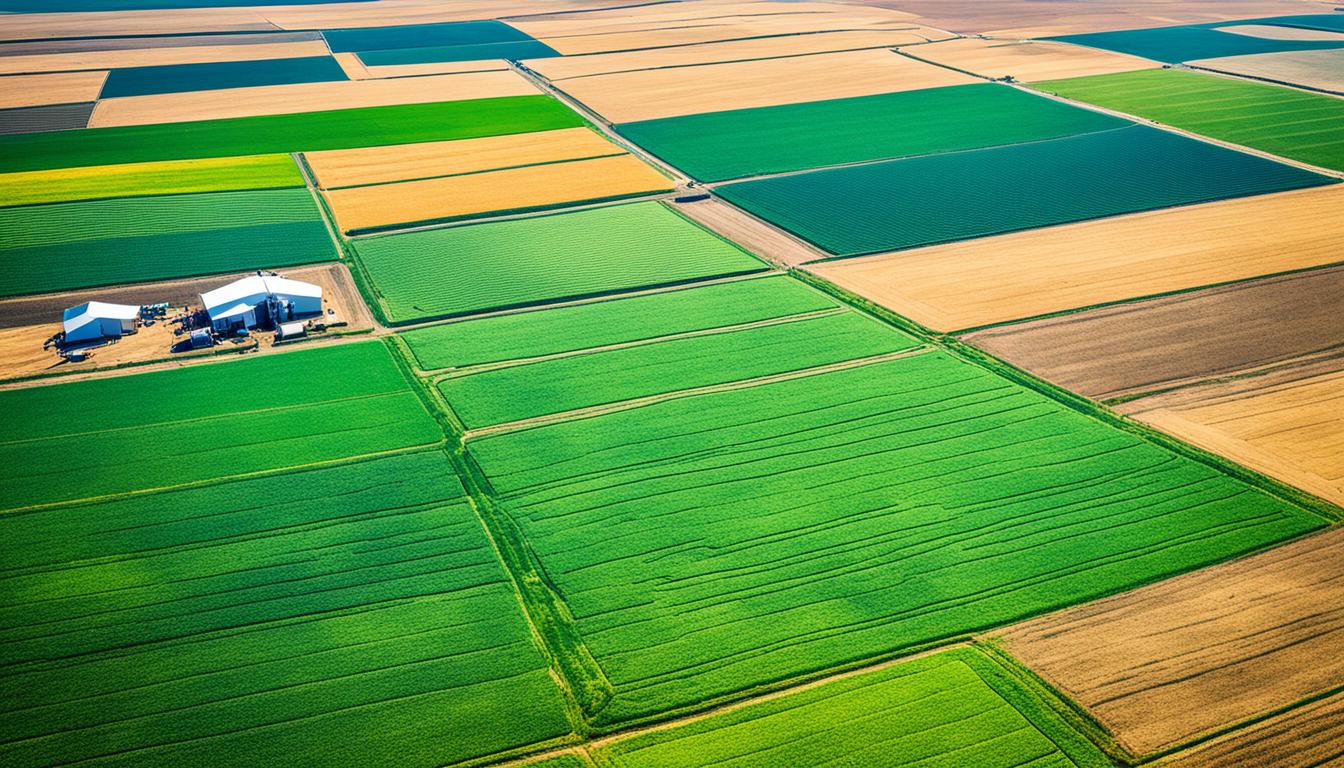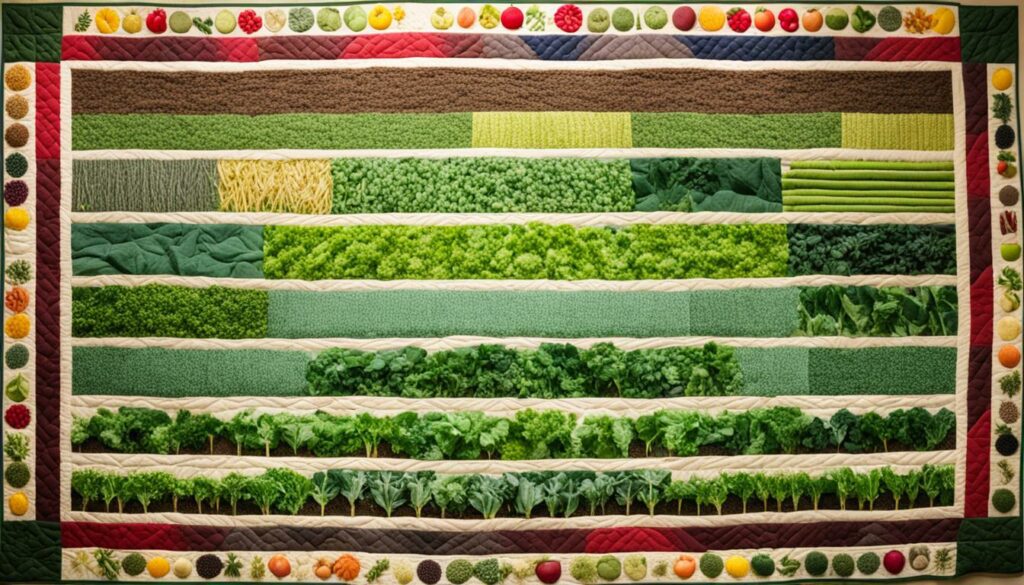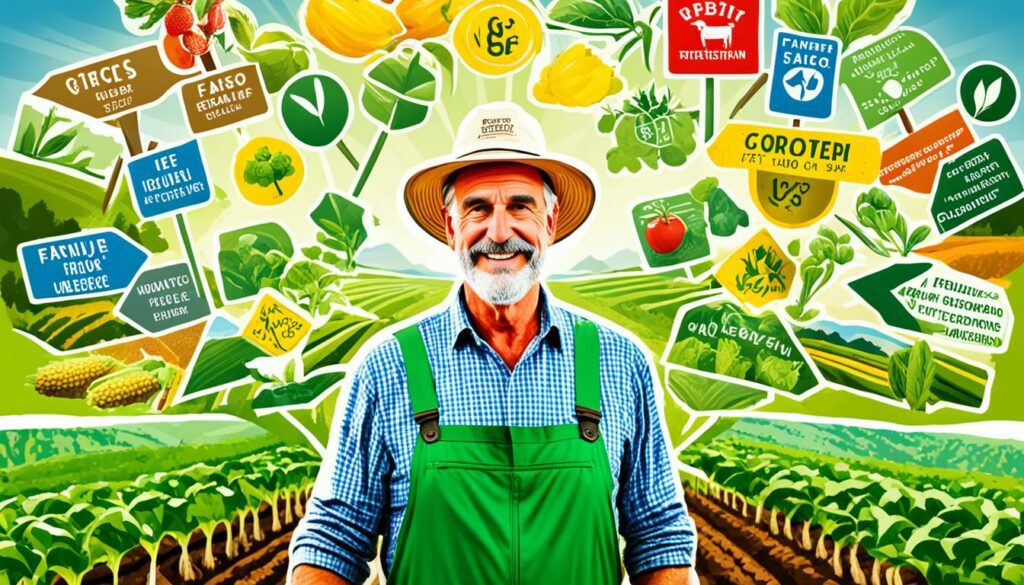Menu

President Biden plans to boost the Agriculture Department’s budget by 7.4% compared to 2023. This change marks a big shift in the focus of 2023’s legislative decisions. They’ve decided to extend the 2018 Farm Bill up to September 2024, thanks to the Further Continuing Appropriations and Other Extensions Act, 2024. This decision means crucial programmes, such as support prices, disaster help, and saving efforts, won’t stop.
At the start of 2023, there was a lot happening in U.S farming policies, as shown by the updates from the House and Senate for their 2024 farm bill plans. While we’re still waiting for the final versions, it’s clear the Senate’s plan will see $500 million more spent, a lot higher than the House’s cut of 30% from the 2023 spending. The Senate was more united in its decision, highlighting a significant rise in their financial backing.
In 2023, the U.S. is focusing more on farming policy updates. This time is very important as it sets the scene for future plans. These plans aim to keep food prices fair, ensure there’s enough food, and protect the environment.
Congress must find a balance between helping the economy and looking after nature. This is key in today’s farming policy talks.
The most recent big farming law, the 2018 Farm Bill, is full of details. It helps with things like what farmers grow and how they sell their goods. It also looks at helping country areas grow. This law started in December 2018 and will end this year. It’s expected to cost nearly $428 billion over five years, with only a small part going to special programs.
Every five years, U.S. farming rules get a big checkup and sometimes a makeover. Key leaders in Congress work on these rule changes. They focus on things like healthy food programs and making sure the land is used well. But some important topics, like how farm workers are treated, aren’t covered yet. This might change in future updates.
The 2018 Farm Bill covers twelve main areas, showing how broad its reach is. It deals with things like helping new farmers, making sure crops are healthy, and growing rural areas. Notably, the law supports those who may find farming difficult, like new farmers and those who’ve served in the military.
Every year, the U.S. shares what it’s doing about farming with others, like the World Trade Organization (WTO). This way, everyone can check if the U.S. is following the rules. It shows how much care goes into making fair and well-thought-out farming laws.
This year, farming policy updates are laying the groundwork for what comes next in 2024. It’s a time to work on challenges and make the farming laws better for the future. Congress hopes these changes will make U.S. farming strong and sustainable.
The 2018 Farm Bill is getting an extension. This move will keep the support for American farming solid. It’s vital till the 2023 Farm Bill runs out. The new extension, until 2023, aims to keep the help going. This support is key for the farming sector to stay strong.

The Farm Bill extension continues to support farmers. It offers them a safety net, ensuring they get fair prices and decent incomes. The Dairy Margin Coverage Program is part of this. It helps dairy farmers feel more secure against shifting market prices. Now, farmers have help facing financial ups and downs.
Conservation efforts also get a boost from this extension. The Conservation Reserve Program (CRP) works on better water and less soil erosion. Now, more land can benefit from these efforts. The act shows how serious everyone is about caring for the land.
| Key Components | 2018 Farm Bill | 2023 Extension |
|---|---|---|
| Expiration Year | 2023 | 2024 |
| Total Projected Cost | $428 billion | $500 million increase |
| Safety Net Programs | Dairy Margin Coverage, etc. | Continued Support |
| Conservation Programs | CRP | Enhanced Funding |
The 2023 appropriations process faces government funding hurdles and legislative roadblocks. These challenges slow down progress. The Senate recently greenlit the 2024 agriculture appropriations bill. It included a $500 million boost from the year before. However, the House offered a different take. Their bill slashed agricultural funding for 2024 by 30% to $8.3 billion, dividing strictly on party lines.
Despite tough negotiations, President Biden aims to hike the Agriculture Department’s funding by 7.4%. This shows a strong commitment to supporting the sector. With the farm bill now running until September 2024, Congress has more time to pass a new one. But, there are major delays in the appropriations process caused by policy disputes. These issues mainly affect the Agriculture and FDA bill.
These conflicts also extend to where IRA funding and SNAP funding will go in the new farm bill. This makes the legislative process even more complex.
The House and Senate have laid out their 2024 Farm Bill proposals. But time to act is running short. A 2024 Farm Bill might not take shape until March, given the packed legislative schedule. This postponement causes further problems, leaving Congress to tackle appropriations process challenges. These unresolved issues might trigger a partial government shutdown.
Below is a summary of the main disagreements in the funding proposals:
| Element | Senate Proposal | House Proposal |
|---|---|---|
| Agriculture Spending Increase | $500 million | 30% ($8.3 billion) decrease |
| SNAP Funding | Under Review | Under Review |
| Climate-Smart Agriculture Initiatives | Supported via IRA | Pushback |
| Policy Provisions | Minimal | Contentious |
It’s critical to overcome these legislative obstacles for agricultural stability. The Senate and House must find common ground to prevent worsening funding and policy stalemates that harm operations. To tackle these appropriations process challenges, a combination of strong legislative foundations and bipartisan teamwork is needed.
The unveiling of the House and Senate summaries for the 2024 Farm Bill is a big step for farming policy. This effort opens the floor for in-depth talks about many areas that impact farmers.

The 2024 Farm Bill proposals highlight major differences between the Senate and House. The House wants to move $14.4 billion to the Farm Bill’s conservation section, helping programs that help farmers in other countries and here at home. It also aims to give more money to research for specialty crops and farming technologies.
The Senate, on the other hand, wants to keep things mostly the same. It supports maintaining how food help levels are figured out. It suggests increasing crop prices by 5%, more funding for fighting animal diseases, and greater efforts to sell American farm products globally.
| Aspect | House Proposal | Senate Proposal |
|---|---|---|
| Conservation Funding | Reallocates $14.4 billion in IRA funds | Continuity with 2018 Farm Bill |
| Market Access and Foreign Market Development | Increased funding | Moderate changes |
| Specialty Crop Research | Increased funding | No specific changes |
| Commodity Crop Prices | Minimal changes | At least 5% increase |
| Animal Disease Response | No specific changes | Increased funding |
| Export Promotion | Increased funding for MAP and FMD | Emphasis on increasing funding |
There’s a big push for bipartisan agreement in the 2024 Farm Bill. The Senate’s ideas focus on American biofuels and making sure the market is fair. They want to improve how livestock is processed and think up ways to make aviation fuel and other products in a green way.
Both sides working together on these issues is key to a strong Farm Bill. The next few weeks could see the bill pass if everyone agrees. If not, they’ll need to start over in 2025.
In 2023, the government will change how it supports farmers and ranchers. These new steps show the government’s detailed look at the financial challenges in agriculture.
The heart of these changes lies in updating the policies on commodities. The President plans to give the Agriculture Department 7.4% more money in 2025. This increase aims to help those in agriculture deal with the ups and downs of the market.
Yet, the bill’s journey has its twists. The House Agriculture Appropriations Subcommittee wants to slash next year’s agricultural funds by 30%. This cut of $8.3 billion means tough times for farmers and ranchers.
“The Senate’s bipartisan approval of the agriculture appropriations bill for fiscal year 2024, which increases funding by $500 million compared to the previous year, highlights a counterbalance focused on nutritional programs like WIC,” an industry watchdog noted.
These new financial moves are all about meeting specific needs. The USDA’s focused steps help more than 30,000 farmers, giving direct support worth $1.7 billion. This shows how various agricultural areas require different types of help.
The world of agricultural policy is changing fast to support key nutritional plans such as SNAP. The Agriculture Improvement Act of 2018 will end in 2023. There is a big push to make sure these programs not only continue but also get better.

The 2018 Farm Bill, which planned to spend about $428 billion over five years, showed how important nutrition programs are. Programs like SNAP are getting more support through changes in agricultural laws. This is to help low-income families who face difficulties in getting enough food.
The SNAP program is at the heart of these new laws. The goal is to keep SNAP improving so it can give needed food help. Thanks to these changes, food needs of many people in the US are better met.
The laws are also focusing on making sure SNAP keeps up with the economy. This is key as different economic conditions change how the SNAP funds are used. The 2018 Farm Bill set aside less than $5 billion for “Other” programs. This means more money can go towards making SNAP and other nutrition programs better.
| Phase | Description |
|---|---|
| Reauthorization | Review and renewal of the farm bill approximately every five years. |
| Appropriations | Allocation of funds to support the provisions and updates within the farm bill. |
| Debate and Voting | Full Congress debates the proposed amendments and votes on the final bill. |
| Presidential Approval | The approved bill is signed into law by the President. |
Rural development plays a key role in making countryside areas better. Throughout this year, there have been big investments and new plans to help rural communities. The goal is to support the economy and social life in rural places, and to deal with their specific needs.
The recent push in rural development focuses on community programmes. The Environmental Protection Agency is giving a big €177 million to help communities access resources and enviro justice. Also, the Economic Development Administration is investing €200 million in big grants to help poor areas grow.
This money should help both farms and other community businesses get stronger.
Better rural housing is vital to improve living conditions and fix bad infrastructures. The Farm Bill suggests spending up to €2.5 billion on rural projects. The Rebuild Rural America Act backs this by suggesting grants go straight to rural councils.
Moreover, the big €387 billion fund, including €95.5 billion from the EAFRD, shows a massive commitment to rural areas. This finance includes flexibility for countries to use the money where it’s most needed.
| Initiative | Details |
|---|---|
| Environmental Justice Thriving Communities Technical Assistance Centers | $177 million investment to support community programs. |
| Recompete Pilot Program by EDA | $200 million investment in large grants to spur economic activity in distressed areas. |
| Rural Investment Initiative for the Farm Bill | Proposes a spending appropriation between $1-2.5 billion for housing and community projects. |
| Rebuild Rural America Act | Block grants directed to regional rural councils for local development. |
| CAP Funding (2021-27) | €387 billion allocation, including €95.5 billion for rural development. |
All these efforts together will greatly improve life in rural places. Around seven percent of jobs in rural areas are in farming. These steps are working for better living and stronger jobs in the countryside. They also aim for a lively and sustainable rural life.
2023 brings new crop production rules focused on quality and long-term sustainability. These rules, known as agricultural production laws, are all about balancing productivity with care for the environment. They highlight the importance of using responsible and sustainable methods that keep our lands safe while ensuring good crop yields.
This year’s laws are a big change, thanks to new decisions on spending. The House Agriculture Appropriations Subcommittee cut agricultural funding by 30% – that’s $8.3 billion less than before. This cut means our farming regulations need to make the most of what’s available, to keep up with high standards.

But, the future looks brighter in terms of funding. President Biden plans to boost Agriculture Department funding by 7.4% next year, showing a push for more resources that support sustainability. The Senate also proposed a $500 million increase in 2024 to help with important nutrition programs.
Looking at the wider picture, these rules are closely linked to the 2024 Farm Bill’s objectives, including discussions within Congress. The key focuses of these funds differ slightly each year. Here is a table showing the changes and major spendings:
| Fiscal Year | Funding Changes | Main Allocation |
|---|---|---|
| 2023 | Base Level | Conservation, Relief Programs |
| 2024 Proposed | 30% ($8.3 billion) reduction (House), $500 million increase (Senate) | WIC, USDA Programs |
| 2025 Proposed | 7.4% increase | Overall USDA Funding |
These new regulations are all about making crop production not just better now, but steadily more eco-friendly and lasting. As we move forward, these 2023 farming regulations will definitely influence how farming is done in the US.
In 2023, there’s a new push for better land use, focusing on eco-friendly farming. The Conservation Reserve Program (CRP) is a key part. Since 1985, it’s helped by setting rules for sustainable agriculture. This year, it’s improved by allowing more land to be saved, which is good for nature and farmers.
The CRP is crucial in making farms and lands better for nature. It lets owners turn risky land into green spaces. This not only makes water and soil better but also helps wildlife. With more land allowed in the program, there’s hope for even more improvements.
The American Farmland Trust (AFT) has helped a lot in making these policies. For over 40 years, they’ve worked on laws that protect farmlands. Thanks to them, actions like the 1981 Federal Farmland Protection Act happened. They also pushed for more money in 2018 for a key protection program. This shows their dedication to the cause.
| Year | Major Milestone |
|---|---|
| 1981 | Enactment of the Federal Farmland Protection Act (FFPA) |
| 1985 | Creation of the first Conservation Title in the Farm Bill |
| 2014 | Reforms requiring conservation plans for crop insurance recipients |
| 2018 | $200 million annual increase for ACEP funding |
| 2022 | Inclusion of technical assistance in USDA relief programs |
Each agency must look at its rules every two years, according to the Farmland Protection Policy Act (FPPA). This makes sure important lands aren’t turned into non-farm use without checking other options first.
Many groups now see the value in the CRP’s plans. For example, the NRCS makes sure projects think about the impact on farmlands. This approach helps in finding other places that might be better for farming’s future.
The rules for 2023 focus on a complete care for nature. They show a joint effort to take care of America’s lands. Thanks to strong policies like the CRP, we’re working hard to leave good land for the next generations.
In 2023, the farming industry saw stricter agricultural industry standards. Now, farms must focus on being both efficient and ethical. This change aims to balance farm productivity with saving the planet.

President Biden wants to give more money to farms in 2025. His budget plans show a big boost of 7.4% in funding. But, the House Committee decided to cut budgets by 30% for the next year. This shows how different parts of the government can have contrasting views.
The rules for farming have been shaped by both Senate and House members. The Senate’s plan is to spend more next year, particularly on a nutrition programme. On the other hand, the House and Senate don’t fully agree on which issues are most important, showing their differences.
The Farm Act from 2018 will stay in place until September 2024. This buys time for Congress to make a new bill. But, if they can’t agree on a new bill by June, it might get delayed until after the 2024 elections. This could cause issues with following the rules and making new policies.
Despite money and political battles, sticking to the agricultural industry standards is still key. Making sure farms follow the current rules is essential. It helps the US farming to meet local needs and protect the environment.
In the United States, agricultural policy is changing. It is not just about saving our lands. It’s also about teaching people important farming skills. This change aims to make our farms last for the future and help our economy grow.
Key to these changes are steps to protect our environment. These efforts are a big part of the $428.3 billion from the 2018 Farm Bill. A lot of this money goes into saving nature through programs like the Conservation Reserve Program (CRP).
For example, the UK’s ELM schemes got £572 million. This money helped around 39,500 farmers look after their land. Thanks to this support, they planted thousands of meters of hedgerow and many trees. This work is crucial in making sure wildlife can thrive.
Helping people learn about farming is just as vital. The Farm Bill supports the training of new farmers, especially those who are from socially disadvantaged or veteran backgrounds. This is to make sure our farms have skilled workers who can bring new ideas.
There is also a push to give rural areas better internet. Around 14.5 million people, a lot of them living in the countryside, don’t have good internet. To fix this, there’s a call for $350 million to improve broadband in these places. This will help rural folks access better healthcare, education, and jobs.
Here are some important facts and actions from these reforms:
| Initiative | Funding/Impact | Details |
|---|---|---|
| Environmental Land Management (ELM) | £572 million | Benefited 39,500 farmers, planted 98,000 meters of hedgerow and 58,000 trees |
| Rural Broadband Deployment | $350 million | Addressed high-speed internet access for 14.5 million Americans |
| SNAP | 75% of 2018 Farm Bill funding | Served 41.5 million low-income individuals |
In short, by changing policies and protecting the environment, the US is making its rural places better. This includes supporting farmers, saving nature, and ensuring people can learn and connect.
In 2023, our push for sustainable agriculture hit a new level. We see the need for farming to be more eco-friendly. The US Department of Agriculture (USDA) is putting in $1.5 billion for this in 2024. This money will go into the Regional Conservation Partnership Program (RCPP).

This year, more than 180,000 farms will benefit. Over the next five years, they are aiming to cover over 225 million acres with new agricultural methods. There’s also a focus on tribal projects, with $100 million set aside for them. The National Resources Conservation Service (NRCS) is working hard on the RCPP, along with other programs.
Thanks to the Biden-Harris Administration, we’ve seen $1.8 billion go into 256 RCPP projects across the US. A key support is the Inflation Reduction Act, bringing over $19 billion to USDA programs, including nearly $5 billion for RCPP. The aim is to make the project start quicker, cutting down negotiation from 15 to 6 months.
“Healthy soils are crucial, not merely for ecosystem diversity and food production, but also for water filtration and carbon capture.”
The Farm Bill plays a big part, adding $6 billion every year for conservation. It shows a big opportunity because over 70% of the US land is available for these plans. The Farm Bill is now extended until September 2024. This ensures support for farming in ways that help the environment and reduce greenhouse gases.
The RCPP has enlisted the help of over 2,000 partners, investing around $1.4 billion. For more than 40 years, they have worked to safeguard wildlife spaces and farmland. Efforts like the Agricultural Conservation Easement Program are paving the way towards a more sustainable future.
The landscape of future agricultural policymaking is changing a lot. Recent trends show farm income is going down. In 2022, it was $185.5 billion. But, by 2024, it’s expected to drop to $116.1 billion. This big drop tells us that we need new ideas to help farmers stay strong.
Net farm income is also falling fast. It was $202.3 billion in 2022. But by 2024, it’s set to hit $121.7 billion. This means farmers will face big financial challenges soon.
It’s not just income going down. Farm cash receipts are also in trouble. They’re expected to drop a lot in 2024. Both crop and animal receipts will be less. Plus, the Government farm payments are going down. So, things are tough for farms all around.
Production expenses are going up too. They’ll rise by $16.7 billion in 2024. This means farmers need to find ways to spend less. Sustainable agriculture projections will be key. They aim to lower costs and protect the environment in the long run.
On the brighter side, farm equity is set to grow by 4.7%. This is a sign of potential stability. But, debt is increasing as well. It’s expected to reach $547.6 billion.
The future of farming relies heavily on sustainable agriculture projections. Policymakers need to support farm resilience and the environment. They must focus on plans that help in the short and long term.
In 2023, U.S. farming has reached a crucial point. The Senate wants to give the Agriculture Department more money to help. They also plan to keep the 2018 Farm Bill working until September 2024. This move offers hope for keeping important support in place. But, the House wants to cut agricultural funding by 30% for the next year. This news is a cause for concern.
The 2018 Farm Bill will stay for now. That means programs like WIC will keep helping those who need it. The Senate also aims to add $500 million for agriculture. However, there are still many challenges. Political issues and disagreements make it hard to move forward. These issues slow down important funding decisions.
In addition, big companies like Tyson Foods are facing challenges. The shutdown of meatpacking plants has led to job losses. This has had a big impact on people who raise animals for these companies. The current situation shows that the farming industry is not without its problems.
Looking ahead, U.S. farming faces many hurdles yet to overcome. The 2024 Farm Bill will play a key role in creating a strong agricultural system. As things change, finding a balance is crucial. This includes balancing the economy, feeding people, and protecting the environment. These factors will shape the future of U.S. farming policy.
In 2023, U.S. farming policy saw big changes. The 2018 Act was extended to September 2024. It covers price support, disaster help, and conservation.
The Bill’s extension supports American farmers. It keeps price and income support steady. Crucial programs like the Dairy Margin Coverage help dairy farmers stay secure.
2023’s funding faces tough times. Delayed funds and strong policy debates slow down critical support. This could cause government shutdowns and more talks.
The Senate aims for agreement, especially in climate funding and farming safety. The House leans towards party lines, showing differences in what’s important. This includes support for crops and nutrition efforts.
Government subsidies shifted in 2023. Changes were made to how commodity programs help. It’s all about addressing different farming needs and recognising the industry’s variety.
Changes to Ag laws strengthen SNAP and other food support. This helps feed low-income families, showing a wider care for food security and public health.
Rural development news shows efforts to boost community programs and housing. It aims to grow the economy and fix infrastructure issues. This includes support for ag-related businesses and wider community efforts.
Rules for producing crops in 2023 focus on quality and being eco-friendly. They make sure farming is done responsibly, keeping the environment in mind.
In 2023, rules on land management continue to embrace the CRP, a conservation effort. More land and money focus on steps that help water and wildlife.
In 2023, farming rules highlight the need for strong standards. They ensure farming meets local and global eco-goals.
Recent reforms target the environment and job training. They aim to keep rural areas nice, and prepare farm workers to innovate and be productive.
In 2023, the focus is on saving soil and water. There’s also a push for green crop types. The goal is to make eco-friendly farming central to U.S. farming.
Looking ahead, U.S. farming policy is in for big changes. The focus is on making policies that make farming more resilient and eco-friendly.